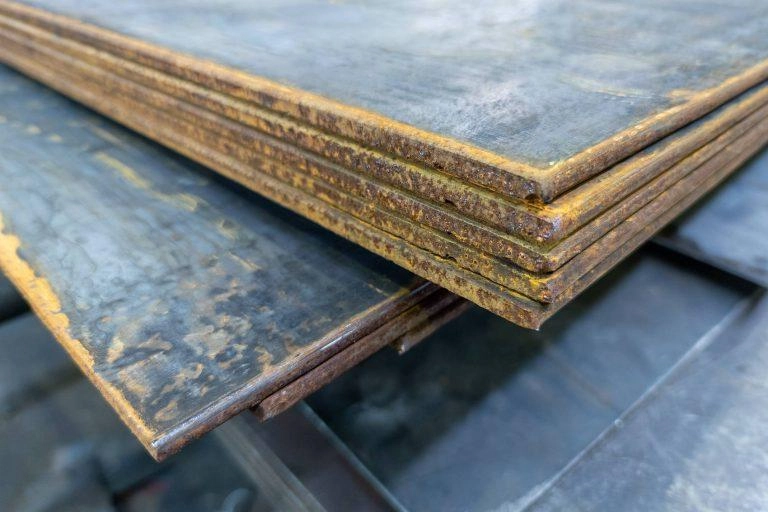Understanding High-Speed Tool Steel
High-speed tool steel (HSS) is a special steel alloy that is highly hardened, wear-resistant and heat-resistant. HSS, patented in 1898 by F.W. Taylor and M. White, made it possible for the cutting tool industry to keep cutting without losing effectiveness at temperatures previously thought to be intolerable. HSS comprise some of the few materials that retain their hardness up to temperature very high temperatures (The ability to retain hardness at elevated temperatures is called red hardness) which enables HSS tools to cut significantly more quickly than comparable cutting tools made of carbon steel.
| Common High-speed Tool Steel Grade | |
| ASTM/AISI | Characteristic |
| M2 | Known for its excellent toughness and wear resistance, making it suitable for general-purpose cutting tools. |
| M42 | Contains a higher cobalt content for superior hot hardness, ideal for heavy-duty cutting tasks. |
| T1 | Offers high toughness with moderate wear resistance, often used in industrial knives and saw blades. |
| T15 | Features exceptional wear resistance due to increased vanadium content, perfect for demanding machining operations. |
Key Properties of High-Speed Tool Steel
Hardness and Wear Resistance
HSS shows Rockwell hardness (HRC) greater than 60 at high temperatures (not more than 500°C). This property of HSS makes it remain sharp and hard even after quenching. HSS has great wear resistance capacity which is the key factor that retains them in exact shapes and sharp edges over prolonged usage. That is why it is perfect for making cutting tools such as drills, milling cutters, reamers, taps and broaches.
Heat Resistance
The most remarkable feature of HSS is that it retains hardness at high temperatures – up to 500°C. In fact, when the temperature is above 200°C, the carbon tool steels start losing hardness crudely and will be not useful at about 500°C while HSS retains its cutting capability. This also lends it a great role in high-speed and hot-cutting operations.
Toughness
Quality toughness of HSS, despite its high hardness. It has outstanding impact and vibration resistance to avoid breakage. This property is vital to avoid unintentional damage to tools while operating in severe applications like cold and hot forming tools like sticks and pins for forging, stamping and extrusion processes.
Dimensional Stability
HSS can withstand dimensional alterations during a heat treatment method like quenching and tempering. It experiences little size variation but precise shape and size, a characteristic that is key to precision mould and gauge production. It has very little increase or reduction in size without losing custom shapes and sizes, which is extremely useful in precision mould and measuring instrument manufacturing.
Production Process of High-Speed Tool Steel
The production of high-speed tool steel involves several intricate processes aimed at achieving the desired mechanical properties.
Melting and Casting
In the beginning, the base materials are melted in electric arc or induction furnaces. The resulting molten metal is then continuously cast into ingots or billets. Great attention is paid to the appropriate distribution of alloying elements in the steel matrix. Alloying elements are introduced in the steel matrix and special care provides the uniform distribution of alloying elements.
Powder Metallurgy
Powder metallurgy (PM) is an important step forward in the manufacture of HSS with enhanced properties over conventional steels. PM is the process of producing fine powders by atomization, compacting the powders at high pressure, and sintering at high temperatures. PM HSS has outstanding hardness caused by uniform microstructure and very fine carbide uniform distribution.
Heat Treatment
The process of heating followed by cooling improves high speed tool steel by varying hardness, toughness and wear resistance to suit the needs of an application, and this is a critical step(( and inseparable as it is a sequenced process; First quench and then temper)). Again, heat treatment is a key process to optimize the performance characteristics of the high-speed tool steel it enables hardness, toughness, and wear resistance to be tailored to the needs of particular applications using a combination of quenching and tempering steps.
Chemical Composition of High-Speed Tool Steel
High-speed tool steel (HSS) is an advanced alloy that includes a range of important alloying elements, each one offering its characteristic to HSS. A basic knowledge of the chemical composition of HSS is necessary to understand how its properties behave and what it can be used for. Chemical composition of HSS to understand the performance characteristics and usages of HSS
The primary constituents of high-speed tool steel include tungsten, molybdenum, chromium, vanadium, and cobalt. These elements play a pivotal role in defining the properties of HSS:
- Tungsten (W):Enhances hardness and heat resistance, contributing significantly to the red hardness of HSS.
- Molybdenum (Mo):Provides similar benefits to tungsten but at a lower cost, improving toughness and wear resistance.
- Chromium (Cr):Increases hardness and corrosion resistance, while also enhancing the steel’s ability to harden in air.
- Vanadium (V):Refines grain size and increases wear resistance by forming hard carbides.
- Cobalt (Co):Boosts hot hardness and strength at elevated temperatures, making it ideal for high-speed cutting applications.
Applications of PromiSpecial High-Speed Tool Steel
PromiSpecial high-speed tool steel is renowned for its versatility across various industrial sectors. Its unique properties make it indispensable in numerous applications where performance under extreme conditions is paramount.
Cutting Tools
High-speed tool steel is widely used in cutting tools like drill bits, milling cutters, reamers, taps and broaches. It will hold its edge at higher temperatures, allowing tools to last longer, while performing reliably for longer periods of time. Thus, HSS becomes indispensable in industries where precision machining is a requisite. Such properties make HSS an extraordinary material in manufacturing sectors needing accurate finish work.
Cold and Hot Forming Tools
HSS stands out in the field of cold and hot forming tools because of its impact load and thermal fatigue toughness. HSS imparts strength and dimensional stability to dies and punches used in forging stamping, and extrusion processes. These features guarantee effective working despite the extreme working conditions.
High-Temperature Bearings
HSS even have applications in non-high-speed machines like high-temperature bearings, where very good wearing resistance is needed and the working condition is at a relatively high temp. Because it maintains structural integrity, it is a good option for components that endure significant frictional forces. Due to its ability to retain its structure, it is ideal for parts subject to high frictional forces.
Automotive and Aerospace Industries
High-speed tool steel is widely used in automotive and aerospace industries where critical components must withstand a lot of stress and extreme conditions. HSS drills have increased production while maintaining accuracy over longer periods of use. HSS. Due to its excellent mechanical properties, HSS are indispensable in aerospace applications such as turbine blades production or other manufacturing processes of high-stress components, where reliability is required.
In short and simply, chemical composition per development plays alongside general applications elucidating the prominence of PromiSpecial high-speed tool steel in varied application fields by purposely remaining aggrandized from conventional application materials like carbon steels or other conventional alloys to hold the industrial importance for materials that are able to sustain in extreme operating conditions while receiving optimum performance continuously over a time period.






















.webp)


